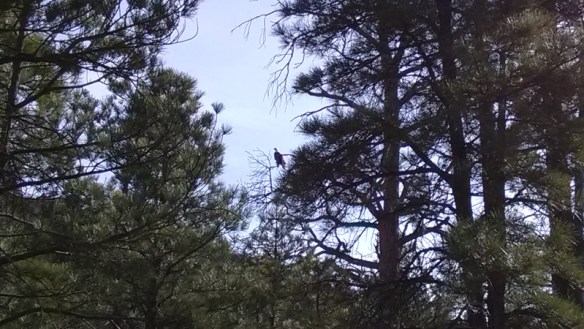 PHOENIX — Arizona’s bald eagles are back, and they will soon be preparing for the next generation of eagles at breeding sites statewide.
PHOENIX — Arizona’s bald eagles are back, and they will soon be preparing for the next generation of eagles at breeding sites statewide.
- A closure for the Verde River below Sycamore Canyon Wilderness is not planned this year unless the eagle pair resumes nesting. Verde River below Sycamore Canyon Wilderness may be closed to foot and vehicle entry from Dec. 1 to June 15. Floating through is allowed, but contact the Coconino National Forest, Red Rock Ranger District office for more information at 928-203-7500 or 928-203-2900.
- Verde River near Chasm Creek is closed to foot and vehicle entry from Dec. 1 to June 30. Floating through is allowed. Contact the Prescott National Forest, Verde Ranger District, at 928-567-4121.
- Verde River near Cold Water Creek, allows watercraft to float through but no stopping on the river or landing is allowed Dec. 1 to June 30. Contact the Prescott National Forest, Verde Ranger District, at 928-567-4121.
- Verde River upstream of the East Verde confluence is closed to vehicle and foot entry from Dec. 1 to June 30. Floating through is allowed, but no stopping in the river or landing is allowed. Contact the Tonto National Forest, Cave Creek Ranger District, at 480-595-3300.
- Verde River near Mule Shoe Bend allows watercraft to float through but no stopping in the river or landing is allowed from Dec. 1 to June 30. Contact the Tonto National Forest, Cave Creek Ranger District, at 480-595-3300.
- Verde River below Bartlett Dam is closed to foot or vehicle entry from Dec. 1 to June 30. Floating through is allowed, but no stopping in the river or landing is allowed. Contact the Tonto National Forest, Cave Creek Ranger District, at 480-595-3300.
- Verde River at the Needle Rock Recreation Area is closed to foot and vehicle entry on portions of the west side of the river from Dec. 1 to June 30. Floating through is allowed, but no stopping in the river or landing on the east side of the river is allowed. Contact the Tonto National Forest, Cave Creek Ranger District, at 480-595-3300.
- Tonto Creek from Gisela to 76 Ranch is not planned to be closed to vehicle, foot entry, and floating through from Dec. 1 to June 30, unless the eagle pair resumes nesting within the closure area. Contact the Tonto National Forest, Tonto Basin Ranger District, at 928-467-3200.
- Tonto Creek inlet to Roosevelt Lake is closed to vehicle and foot entry within 1,000 feet of the nest on land and to watercraft within 300 feet on water from Dec. 1 to June 30. Contact the Tonto National Forest, Tonto Basin Ranger District, at 602-225-5395.
- Salt River from Horseshoe Bend to Redmond Flat allows watercraft to float through, but no stopping in the river or landing is allowed from Dec. 1 to June 30. Contact the Tonto National Forest, Globe Ranger District, at 928-402-6200.
- Salt River near Meddler Point is closed to vehicle and foot entry within 1,000 feet of the nest on land and to watercraft within 300 feet on water from Dec. 1 to June 30. Contact the Tonto National Forest, Tonto Basin Ranger District, at 602-225-5395.
- Salt River below Stewart Mountain Dam is closed to vehicle or foot entry on the south side of the river from Dec. 1 to June 30. Floating through is allowed. Contact the Tonto National Forest, Mesa Ranger District, at 480-610-3300.
- Salt River near Goldfield-Kerr Fire Station is closed to foot and vehicle entry on the north side of the river from Dec. 1 to June 30. Floating through is allowed. Contact the Tonto National Forest, Mesa Ranger District, at 480-610-3300.
- Enjoy bald eagles from outside the closures, which are marked with signs and/or buoys. Watch from a distance using a spotting scope, binoculars or telephoto camera lens. If the eagles are persistently watching you, observation at a greater distance is advised.
- Anyone approached by a nestwatcher and asked to cease an activity or leave a closed area should comply. A few good places to see bald eagles without disturbing them (during December and January) are at Lake Mary and Mormon Lake near Flagstaff, on the Verde Canyon Train in Clarkdale, or Roosevelt Lake.
- Bald eagles protecting an active nest will let you know if you are too close. If a bald eagle is vocalizing and circling the area frantically, you are too close and need to leave the area quickly. Bald eagles incubating eggs or brooding small young should never be off the nest for more than 15 minutes.
- Help from anglers is especially needed. Fishing line and tackle have killed two nestlings and been found in two-thirds of all bald eagle nests in the state. Biologists remove these lethal hazards from nests and/or entangled nestlings every year. Discard any fishing line properly in specially-marked recycling containers or at fishing stores. Also, use fresh line that isn’t old and brittle. Use the correct test line for the fish you are trying to catch. Also, do not cut the line when an undesirable fish is caught and return it to the water with the hook and line attached.
- Duck hunters should scout out their hunting area to ensure that bald eagles are not nesting nearby.

 PHOENIX — The camera is set, zoomed in and ready to broadcast the day-to-day life of a pair of bald eagles hoping to raise a family inside their nest at Lake Pleasant Regional Park.
PHOENIX — The camera is set, zoomed in and ready to broadcast the day-to-day life of a pair of bald eagles hoping to raise a family inside their nest at Lake Pleasant Regional Park.



